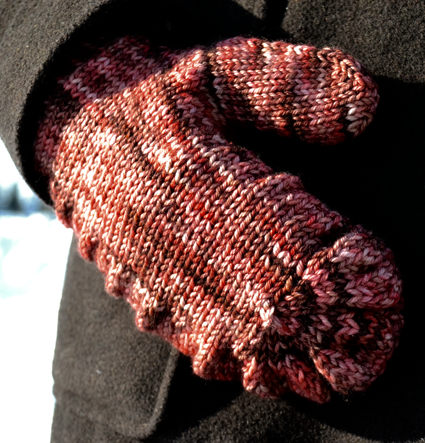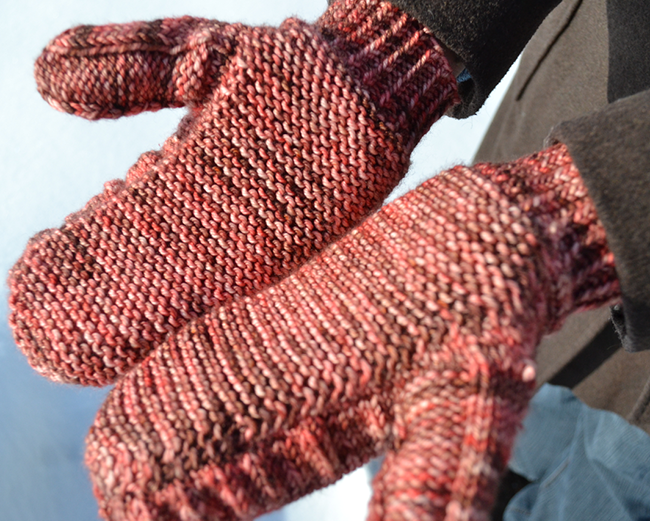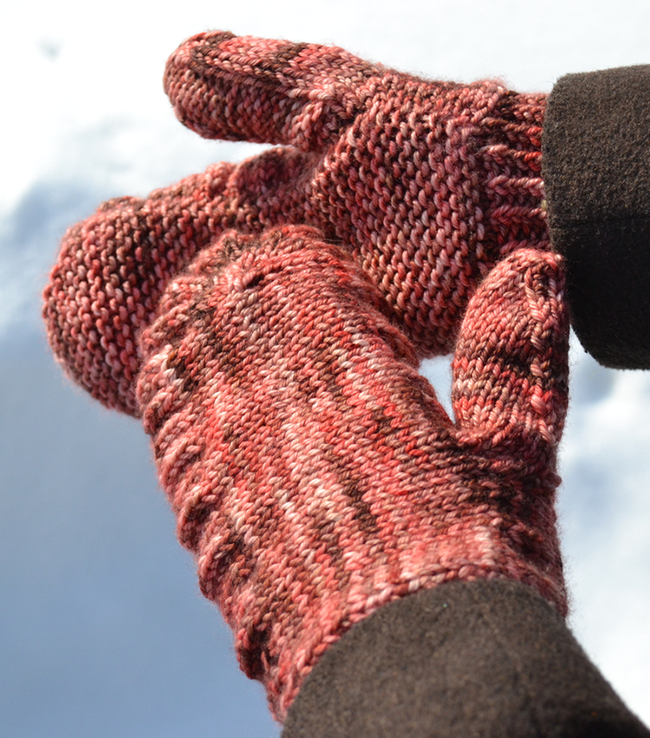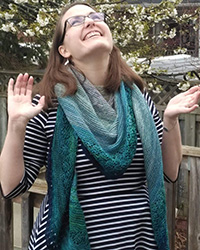Pomegranate Ripple, a free knitting pattern from Knitty.com. Free knitting pattern for a DETAILS HERE.
INTRODUCTION
Pomegranate Ripple
 by Anne Blayney
by Anne Blayney
![]()
What if you were to knit a pair of mittens from the palm out? I've long admired the creativity so many Knitty designs, from Skew and Wraptor to Spatterdash and Longitudinal, where the designers have turned standard constructions entirely upside down (or sideways, or inside out). I wanted to challenge myself to rethink mitten construction in a similar way.
These mittens start with a flat garter stitch slab for the palm. Then, you pick up and knit around the palm, and work lots of increases to build the fabric around the hand. Next come lots of decreases, giving the mitten its distinctive ripples, inspired by the gathers on boxing gloves. Finally, you graft the back of the hand shut, and pick up and work the thumb and the cuff.
 photos: Mark Whitcombe and Anne Blayney
photos: Mark Whitcombe and Anne Blayney
SIZE
Child 4-8 years[Adult Small, Adult Large]
FINISHED MEASUREMENTS
Circumference at Palm: 5.75[7.5, 9.75] inches/ 14.5[19, 24.5] cm
Hand Length (not including cuff: 6.0[7.25, 9] inches, 15[18.5, 22.5] cm
Cuff Length: 1.5[2, 2.75] inches/ 4[5, 7] cm, or adjustable to preference
Choose the size closest to the wearer's actual hand circumference. A little positive ease is good for extra warmth or growing room, but a little negative ease makes for better dexterity if you're wrangling keys, dog leashes, and that sort of thing.
For hand length, measure from the very base of the palm to the tip of the longest finger.
The cuff length is easily adjusted, but changes will impact yardage needs. The cuff is intended to fit snugly to keep the mittens in place and keep snow from getting in!
MATERIALS
Yarn Characteristics: Using a handpainted yarn emphasizes the shifting directions of the stitches, as does working with a commercial variegated yarn. A long color-shift yarn or self-striping yarn would be another fun option. If working with solid-colored yarn, consider working the palm, the back-of-hand graft, and/or the bind-off in a contrast color, as shown in the large sample.
Sizing in this pattern is achieved by changing the yarn weight and needle size. Sport-weight yarn will achieve a child-sized mitten; worsted weight yarn will achieve a small adult mitten; and a chunky yarn will achieve a large adult mitten.
When choosing yarn and needles, bear in mind that mittens, like socks, get lots of wear. These mittens are worked at a tighter gauge than the yarn label might indicate, or than you might use for a hat or other accessory in the same yarn. Be prepared for an unusual row gauge!
Needles: I normally try to make my designs as needle-agnostic as possible, so that you can use whichever style of needles you prefer. However, there is a tricky maneuver at the back of the hand in these mittens. Even though you're not working in the round at that point, either a long circular needle for magic loop or 2 circular needles (used as for knitting small circumferences) will make your life much easier. You can use your usual preferred method for working small circumferences in the round, including circs or DPNs, for the thumbs and cuffs.
![]()
Size: 4-8 Years
Yarn
![]() Cascade 220 Superwash Sport [100% superwash merino; 136 yd/125 m per 1.75 oz/50 g skein]; color: 113 (red-orange multi); 2 skeins.
Cascade 220 Superwash Sport [100% superwash merino; 136 yd/125 m per 1.75 oz/50 g skein]; color: 113 (red-orange multi); 2 skeins.
Note: Only a few yards of the second skein were required for the sample; you may or may not need to break into your second skein.
[always use a needle size that gives you the gauge listed below - every knitter's gauge is unique]
GAUGE
25 sts/42 rows = 4 inches/10 cm in stockinette stitch on smaller needles
![]()
Size: Adult Small (shown at top)
Yarn
![]() Yarn Indulgences Zed MCN Worsted [80% superwash merino, 10% cashmere, 10% nylon; 200 yd/183 m per 4 oz/115 g skein]; color: Pomegranate; 1 skein
Yarn Indulgences Zed MCN Worsted [80% superwash merino, 10% cashmere, 10% nylon; 200 yd/183 m per 4 oz/115 g skein]; color: Pomegranate; 1 skein
Recommended needle size
[always use a needle size that gives you the gauge listed below - every knitter's gauge is unique]
![]() US #7/4.5 mm needles for working flat
US #7/4.5 mm needles for working flat
![]() US #6/4 mm circular needles – 2 shorter or one 32-40 inch/80-100cm for magic loop technique
US #6/4 mm circular needles – 2 shorter or one 32-40 inch/80-100cm for magic loop technique
![]() US #6/4 mm traditional or flexible DPNs – optional for thumbs
US #6/4 mm traditional or flexible DPNs – optional for thumbs


GAUGE
19 sts/29 rows = 4 inches/10 cm in stockinette stitch on smaller needles
![]()
Size: Adult Large
Yarn
Estelle Chunky [50% acrylic, 40% wool, 10% nylon; 136 yd/125 m per 3.5 oz/100 g skein];
![]() [MC] Q63306 (red); 1 skein
[MC] Q63306 (red); 1 skein
![]() [CC] Q63391 (gray); 1 skein
[CC] Q63391 (gray); 1 skein
Note: Sample is shown below in two colors. Approximately 125 gr used in total, so even if you use one color you will need two skeins.
Recommended needle size
[always use a needle size that gives you the gauge listed below - every knitter's gauge is unique]
GAUGE
16 sts/24 rows = 4 inches/10 cm in stockinette stitch on smaller needles
![]()
PATTERN NOTES
[Knitty's list of standard abbreviations and techniques can be found here.]
CDD: Work a centered double decrease knit wise as follows: slip 2 sts together, knitwise; k1, then slip 2 sts over stitch just knit. 2 sts decreased.
pCDD: Work a centered double decrease purl wise as follows: slip 2 stitches, 1 at a time, knitwise; slide them back onto the left needle as a unit, purlwise; then purl 3 sts together (the 2 you slipped plus the next 1 on the left needle). 2 sts decreased.
Grafting:
Instructions for grafting can be found here and here.
DIRECTIONS

Palms (Make 2):
CO 17 sts on larger needles using long-tail cast-on.
Work 60 rows in garter st, for 30 ridges.
Row 1 [RS]: K1, K2tog, K to 3 sts before end, SSK, K1. 2 sts decreased.
Row 2 [WS]: K across.
Rows 3 and 4: Knit next 2 rows plain.
Repeat Rows 1-2 4 times more. 7 sts rem.
BO.
Break yarn.
LEFT HAND
Row 1 [RS]: Note: You will work using magic loop or two circulars, as if you were working in the round, but you will be working back and forth in a U-shape.
Using smaller needle, rejoin yarn at bottom right of one palm piece and with RS facing, pick up and knit around the edge of the palm as follows: 28 sts along the first side (1 in each of the garter ridges), 6 sts along the diagonal, 7 sts along the top – pulling out the loop of the magic loop, or changing to a second circular needle halfway along – 6 sts along the next diagonal, and 28 sts along the second side (1 in each of the garter ridges). 75 sts.
Row 2 and all even rows to Row 16 [WS]: Purl.
Row 3: K1, M1R; (k2, M1R) 13 times; (k1, M1R) 20 times, k1; (M1R, k2) 13 times; M1R, k1. 123 sts.
Row 5: K41; M1R, (k2, M1R) 20 times; k22; using waste yarn, K9. Slide these 9 sts back to the left needle, and, using project yarn again, k to end of row. 144 sts. (The sts held on waste yarn will later become the thumb.)
Row 7: K all sts.
Row 9: (K1, k2tog) 14 times, place marker; k2tog 15 times; k1; k2tog 15 times; (k2tog, k1) 13 times, k2. 87 sts.
Row 11: K to marker; (k2tog, k1) 10 times; k2tog; k to end. 76 sts.
Row 13: K to marker; k2tog 5 times, k1, k2tog 5 times; k to end. 66 sts.
Row 15: K to marker; (k2tog, k1) 3 times, k2tog; k to end. 62 sts.
Row 17: K to marker; k2tog, CDD, k2tog; k to end. 58 sts.
Row 18: P27, pCDD. 56 sts. End here, at the halfway point of the row, at the fingertip end.
Break yarn, leaving an approximately 1yd/1m tail. You will have 28 sts on each needle. Graft the sides together using Kitchener stitch.

Left Thumb:
Set-up: Using smaller needles for small circumference in the round, carefully remove waste yarn from thumb sts, placing the resulting live sts onto two needles; one for the 9 sts below the thumb hole and one needle for the 9 sts above the thumb hole. 18 sts.
Round 1: With the back of the mitten facing you and the fingertip end of the mitten to your left, rejoin the working yarn and pick up and knit 1 st at the side gap between the upper and lower thumb sts; knit the 9 sts on the lower needle, then pick and knit 1 st in the side gap. Knit the 9 sts on the upper side, then pick and knit 1 more st. 21 sts. Distribute sts as you prefer and join for working in the round.
Rounds 2-5: K11, p6, k4.
Round 6: SSK, k9, M1R, p6, k4.
Rounds 7-8: K11, p6, k4.
Repeat Rounds 6-8 3 more times.
Round 18: SSK, k9, p6, k2, k2tog. 19 sts.
Round 19: SSK, k6, k2tog, p2tog, p4, k1, k2tog. 15 sts.
Round 20: SSK, k4, k2tog, p2tog, p3, k2tog. 11 sts.
Round 21: SSK, k2, k2tog, p2tog, p2, k1. 8 sts.
Break yarn and graft remaining sts.
RIGHT HAND
Row 1 [RS]: Note: You will work using magic loop or two circulars, as if you were working in the round, but you will be working back and forth in a U-shape.
Using smaller needle, rejoin yarn at bottom right of one palm piece and with RS facing, pick up and knit around the edge of the palm as follows: 28 sts along the first side (1 in each of the garter ridges), 6 sts along the diagonal, 7 sts along the top – pulling out the loop of the magic loop, or changing to a second circular needle halfway along – 6 sts along the next diagonal, and 28 sts along the second side (1 in each of the garter ridges). 75 sts.
Row 2 and all even rows to Row 16 [WS]: Purl.
Row 3: K1, M1R; (k2, M1R) 13 times; (k1, M1R) 20 times, k1; (M1R, k2) 13 times; M1R, k1. 123 sts.
Row 5: K 10; using waste yarn, k9. Slide these 9 sts back to the left needle, and, using project yarn again, k31. M1R, (k2, M1R) 20 times; k to end. 144 sts. (The sts held on waste yarn will later become the thumb.)
Complete as for LEFT HAND.
Right Thumb:
Set-up: Using smaller needles for small circumference in the round, carefully remove waste yarn from thumb sts, placing the resulting live sts onto two needles; one for the 9 sts below the thumb hole and one needle for the 9 sts above the thumb hole. 18 sts.
Round 1: With the back of the mitten facing you and the fingertip end of the mitten to your left, rejoin the working yarn and pick up and knit 1 st at the side gap between the upper and lower thumb sts; knit the 9 sts on the lower needle, then pick and knit 1 st in the side gap. Knit the 9 sts on the upper side, then pick and knit 1 more st. 21 sts. Distribute sts as you prefer and join for working in the round.
Rounds 2-5: K4, p6, k11.
Round 6: K4, p6, M1R, k9, k2tog.
Rounds 7-8: K4, p6, k11.
Repeat Rounds 6-8 3 more times.
Round 18: SSK, k2, p6, k9, k2tog. 19 sts.
Round 19: SSK, k1, p4, p2tog, SSK, k6, k2tog. 15 sts.
Round 20: SSK, p3, p2tog, SSK, k4, k2tog. 11 sts.
Round 21: K1, p2, p2tog, SSK, k2, k2tog. 8 sts.
Break yarn and graft remaining sts.
Cuffs:
Work the same for each mitten.
Using smaller needles, rejoin working yarn with the palm facing you, and pick up and knit around the base of the mitten: 1 st into each st of the palm and 2 st into every 3 rows of the back. 40 sts.
Distribute sts as you prefer and join for working in the round.
Ribbing round: [K1tbl, p1] around.
Work 12 rounds total, or to your preferred length.
Bind off loosely in ribbing.
FINISHING
Wash mittens and lay flat to dry. You may wish to stuff them with a crumpled plastic bag to retain some of the dimensionality during drying. Weave in ends.
ABOUT THE DESIGNER
 Anne Blayney is a conference planner in Kitchener, Canada, where she lives with her husband and posts far too many Instagram pictures of her dog. She learned to knit from Knitty Editor Amy's book Knit Wit back in the early days of Knitty, so being published here feels like her knitting has come full circle.
Anne Blayney is a conference planner in Kitchener, Canada, where she lives with her husband and posts far too many Instagram pictures of her dog. She learned to knit from Knitty Editor Amy's book Knit Wit back in the early days of Knitty, so being published here feels like her knitting has come full circle.
Pattern & images © 2020 Anne Blayney.